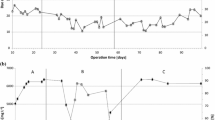Abstract
This paper presents results on anaerobic degradation of the azo dye blue HFRL in a bench scale Upflow anaerobic sludge blanket (UASB) reactor operated at ambient temperature. The results show that the addition of yeast extract (500 mg/L) increased color removal (P < 0.05) from 62 to 93% despite the low chemical oxygen demand (COD) removal (~35%) which happened due to volatile fatty acids (VFA) accumulation. There were no differences in color removal (~91%) when yeast extract (500 mg/L) was used in the presence or absence of glucose, suggesting that yeast extract acted as source of redox mediator (riboflavin) and carbon. The specific rate of dye removal increased along the operational phases and depended on the presence of yeast extract, suggesting progressive biomass acclimatization. Analysis of bacterial diversity by Polymerase Chain Reaction-Denaturing Gradient Gel Electrophoresis (PCR–DGGE) method showed there was biomass selection along the bioreactor operation and no evidence of azo dye degrading bacteria predominance. This strengthens the hypothesis that color removal happens extracellularly by the reduction of azo bond by reduced redox mediators, such as riboflavin, which is present in high amount in the yeast extract.





Similar content being viewed by others
References
APHA (2005) Standard methods for the examination of water and wastewater, 21st edn. EUA. American Public Health Association, Washington, D.C
Aquino SF, Stuckey DC (2003) Soluble microbial products (SMP) formation in anaerobic chemostats in the presence of toxic compounds. Water Res 38:255–266
Aquino SF, Chernicharo CAL, Foresti E, Santos MLF dos, Monteggia LO (2007) Metodologias para determinação da atividade metanogênica específica (AME) em lodos anaeróbios. Eng Sanit Amb 12:192–201
Bhatt N, Patel KC, Keharia H, Madamwar D (2005) Decolorization of diazo dye reactive blue 172 by Pseudomonas aeruginosa. J Basic Microbiol 45:407–418
Cervantes FJ, Enriquez JE, Mendoz A, Hernandes ZMR, Razo-Flores E, Field JA (2006) The role of sulphate reduction on the reductive decolorization of the azo dye reactive orange 14. Water Sci Technol 54:171–177
Chernicharo CAL (2007) Princípios do tratamento biológico de águas residuárias “Reatores Anaeróbios”. Editora UFMG, Belo Horizonte
CONAMA (2005) National Council of Environment resolution number 357, March 17, Brasil
Dos Santos AB (2005) Reductive decolourisation of dyes by thermophilic anaerobic granular sludge. PhD thesis, Wageningen University
Dos Santos AB, Cervantes FJ, Yaya-Beas RE, Van Lier JB (2003) Effect of redox mediator, AQDS, on the decolourisation of a reactive azo dye containing triazine group in a thermophilic anaerobic EGSB reactor. Ezyme Microb Tech 33:942–951
Dos Santos AB, Cervantes FJ, Van Lier JB (2006) Potentials of high-temperature anaerobic treatment and redox mediators for the reductive decolourisation of azo dyes from textile wastewaters. Water Sci Tecnol 54:151–156
Dos Santos AB, Cervantes FJ, Van Lier JB (2007) Impacto dos mediadores redox na remoção de cor de corantes azo e antraquinônico por lodo granular anaeróbio sob condições mesofílicas e termofílicas. Eng Sanit Amb 12:102–108
Field JA, Brady J (2003) Riboflavin as a redox mediator accelerating the reduction of azo dye mordant yellow 10 by anaerobic granular sludge. Water Sci Technol 48:187–193
Georgiou D, Metallinou C, Aivasidis A, Voudrias E, Gimouhopoulos K (2004) Decolorization of azo-reactive dyes and cotton-textile wastewater using anaerobic digestion and acetate-consuming bacteria. Biochem Eng J 19:75–79
Griffiths RI, Whiteley AS, O′Donnell AG, Bailey MJ (2000) Rapid method for coextraction DNA and RNA from natural environments for analysis of riobosomal DNA- and rRNA-based microbial community composition. Appl Environ Microbiol 66:5488–5491
Isik M, Sponza DT (2003) Effect of oxygen on decolorization of azo dyes by Escherichia coli and Pseudomonas sp. and fate of aromatic amines. Process Biochem 38:1183–1192
Isik M, Sponza DT (2008) Anaerobic/aerobic treatment of a simulated textile wastewater. Sep Purif Technol 60:64–72
Kalyani DC, Patil PS, Jadhav JP, Govindwar SP (2008) Biodegradation of reactive textile dye red BLI by an isolated bacterium Pseudomonas sp. SUK. Bioresour Technol 99:464–4635
Mendez-Paz D, Omil F, Lema JM (2005) Anaerobic treatment of azo dye acid orange 7 under batch conditions. Ezyme Microb Tech 36:264–272
Muyzer G, Wall EC, Uitterlinden AG (1993) Profiling of complex microbial populations by denaturing gradient gel electrophoresis analysis of polymerase chain reaction-amplified genes coding for 16S rRNA. Appl Environ Microbiol 59:695–700
Nigam P, Banat IM, Singh D, Marchant R (1995) Microbial process for the decolorization of textile effluent containing azo, diazo and reactive dyes. Process Biochem 31:435–442
Ortiz ACT (2008) Tratamento biológico com biomassa suspendida anaeróbico/aeróbico de efluente de uma indústria têxtil contendo corante azo. In: XXXI Congresso Interamericano AIDIS, Santiago, Chile
Rau J, Knackmuss HJ, Stolz A (2002) Effects of different quinoid redox mediators on the anaerobic reduction of azo dyes by bacteria. Environ Sci Tech 36:1497–1504
Somasiri W, Li XF, Ruan WQ, Jian C (2008) Evaluation of the efficacy of upflow anaerobic sludge blanket reactor in removal of colour and reduction of COD in real textile wastewater. Bioresource Technol 99:3692–3699
Van der Zee FP, Cervantes J (2009) Impact and application of electron shuttles on the redox (bio) transformation of contaminants: a review. Biotechnol Adv 27:256–277
Van der Zee FP, Villaverde S (2005) Combined anaerobic–aerobic treatment of azo dyes—a short review of bioreactor studies. Water Res 39:1425–1440
Acknowledgments
The authors would like to thank the following institutions for their financial support: Coordenação de Aperfeiçoamento de Pessoal de Nível Superior–CAPES, Conselho Nacional de Desenvolvimento Científico e Tecnológico–CNPq, Fundação de Amparo à Pesquisa do Estado de Minas Gerais–FAPEMIG, Universidade Federal de Ouro Preto-UFOP.
Author information
Authors and Affiliations
Corresponding author
Rights and permissions
About this article
Cite this article
Baêta, B.E.L., Aquino, S.F., Silva, S.Q. et al. Anaerobic degradation of azo dye Drimaren blue HFRL in UASB reactor in the presence of yeast extract a source of carbon and redox mediator. Biodegradation 23, 199–208 (2012). https://doi.org/10.1007/s10532-011-9499-4
Received:
Accepted:
Published:
Issue Date:
DOI: https://doi.org/10.1007/s10532-011-9499-4




